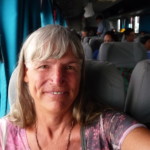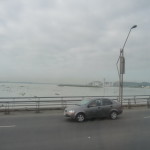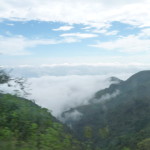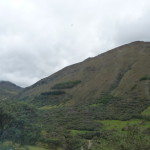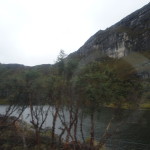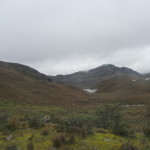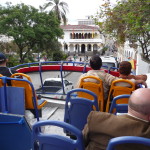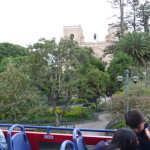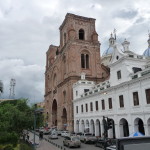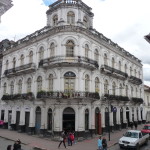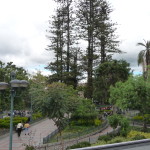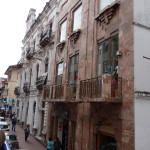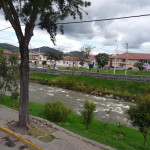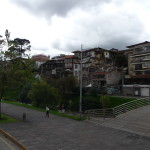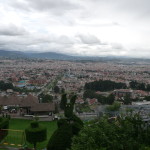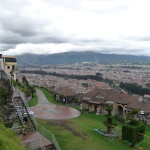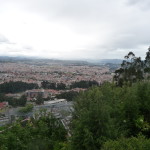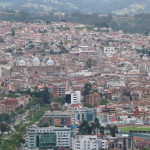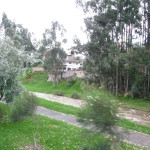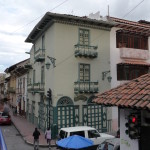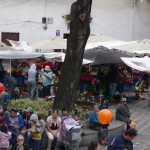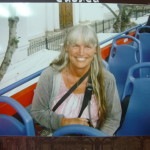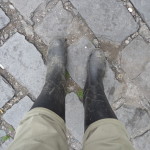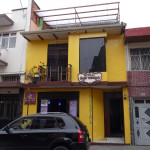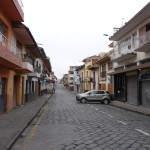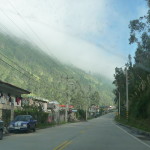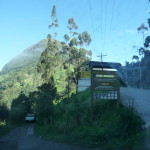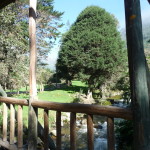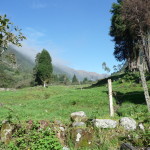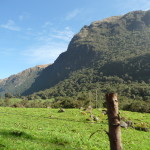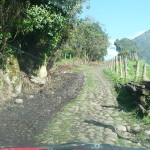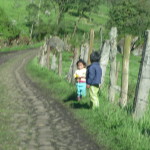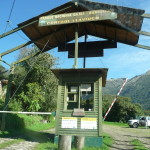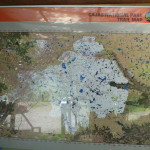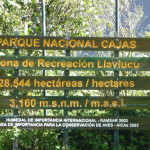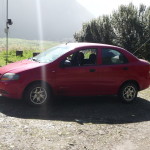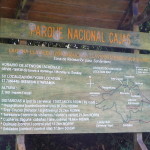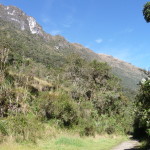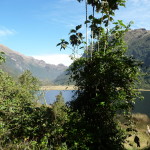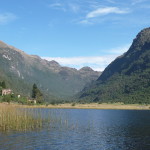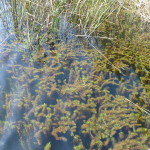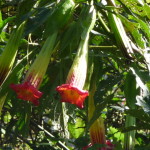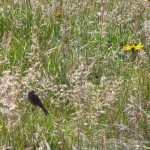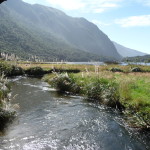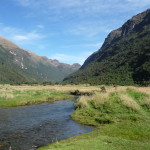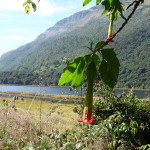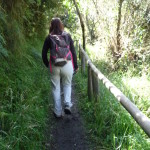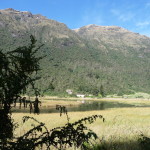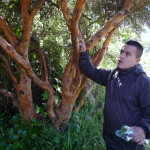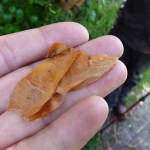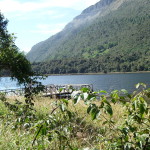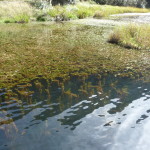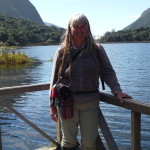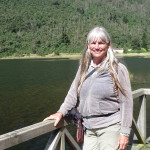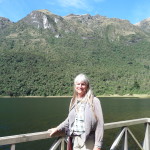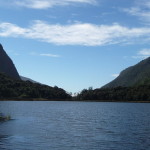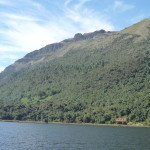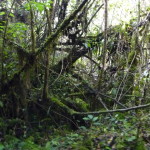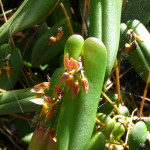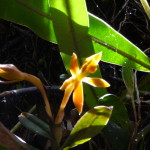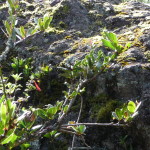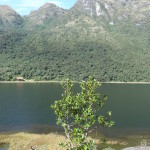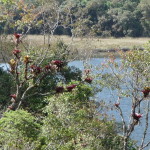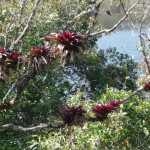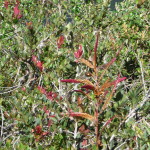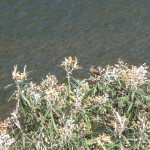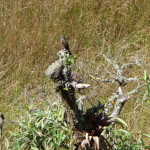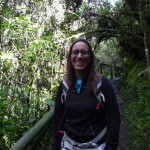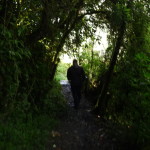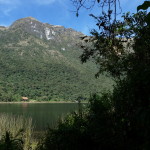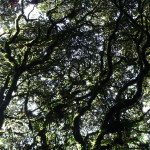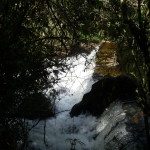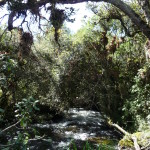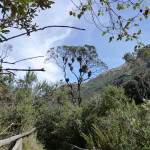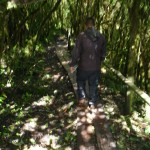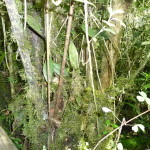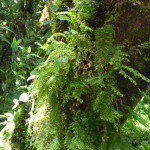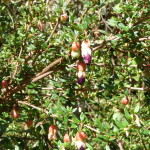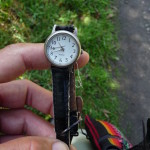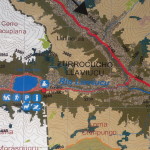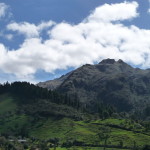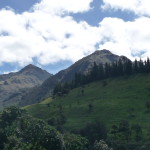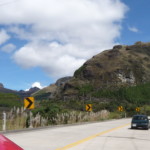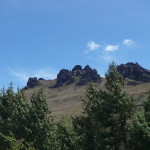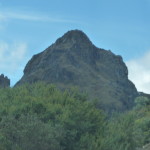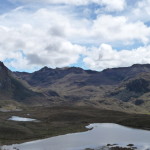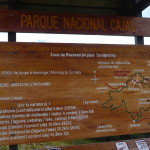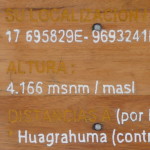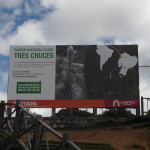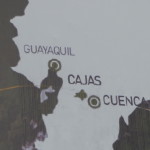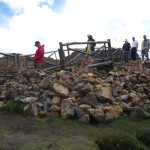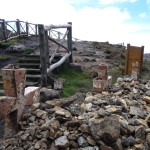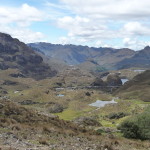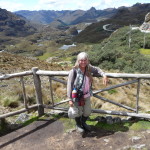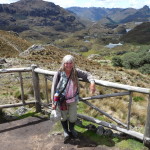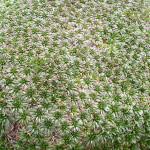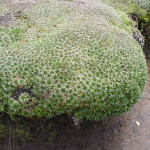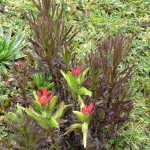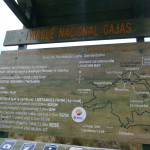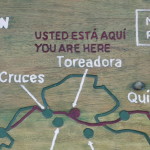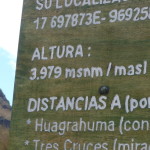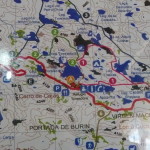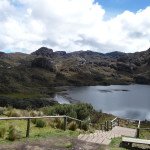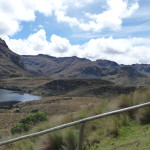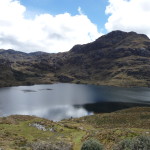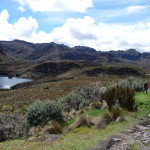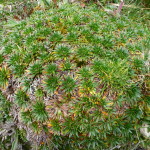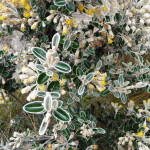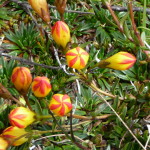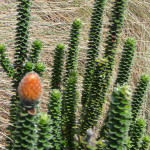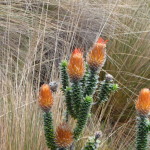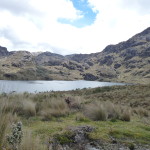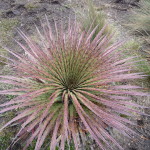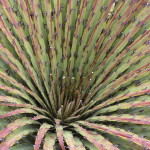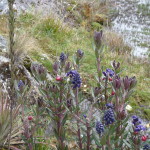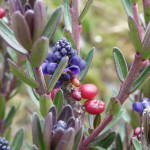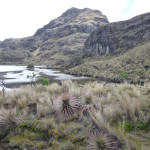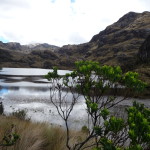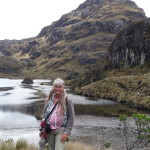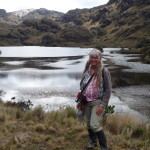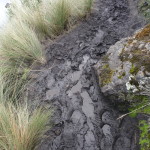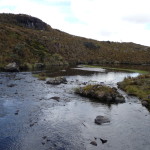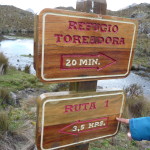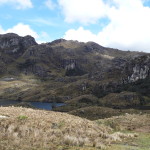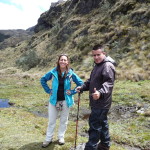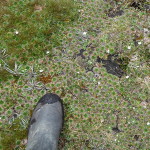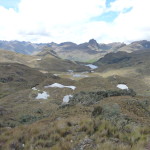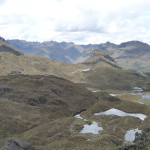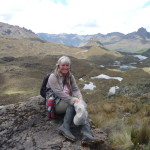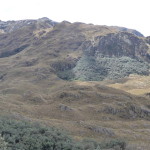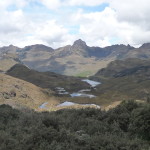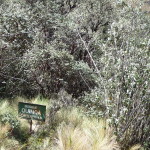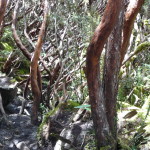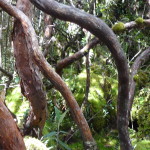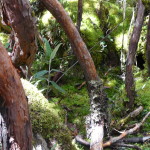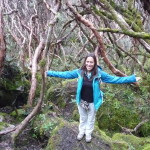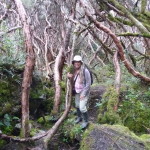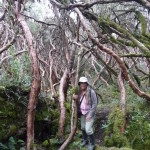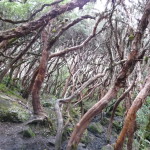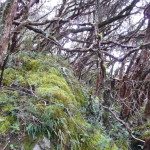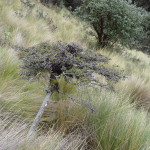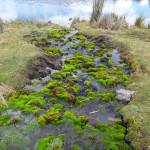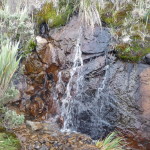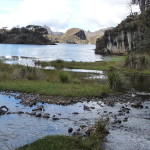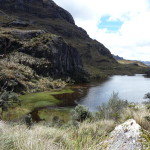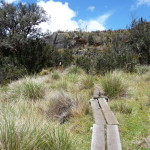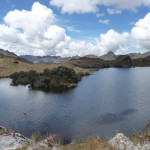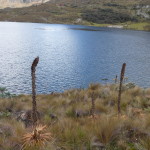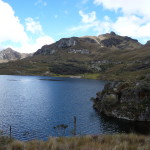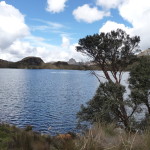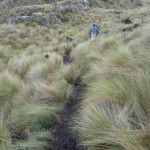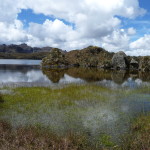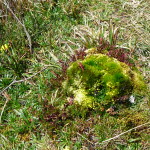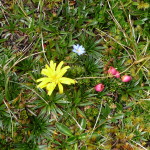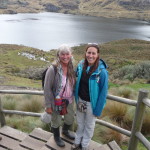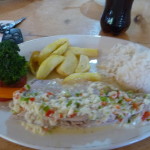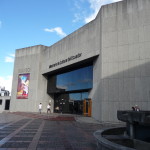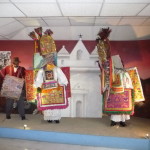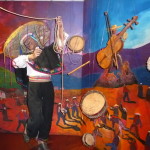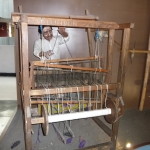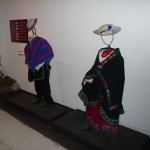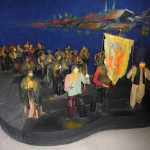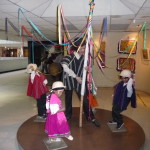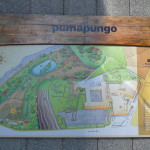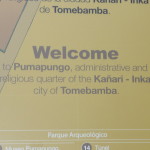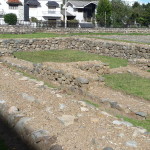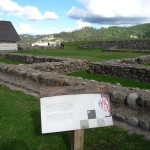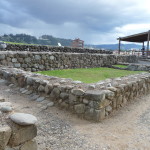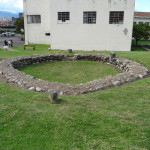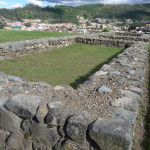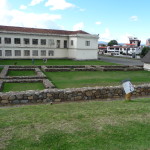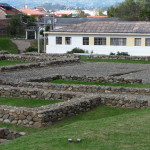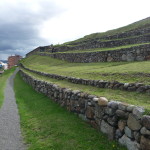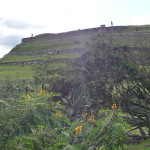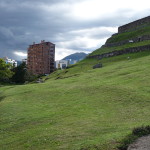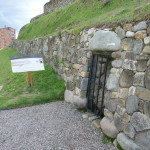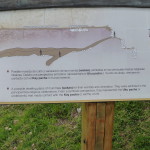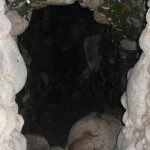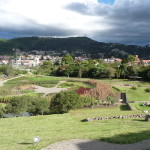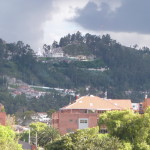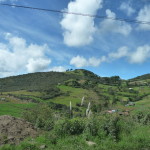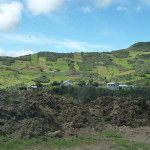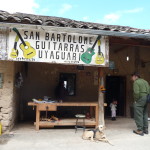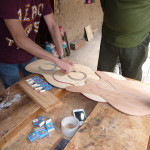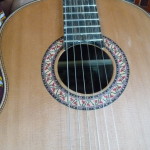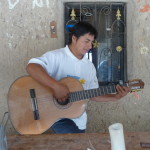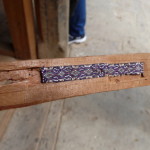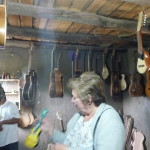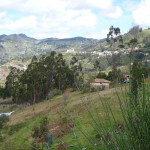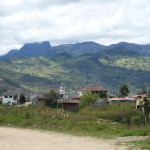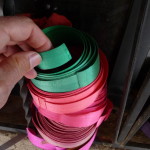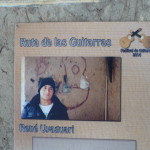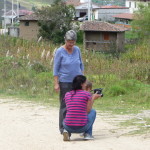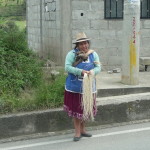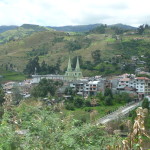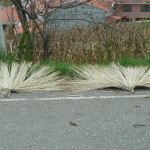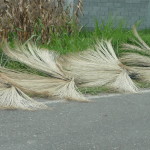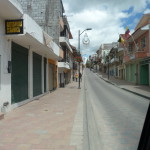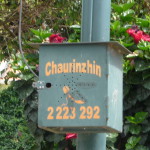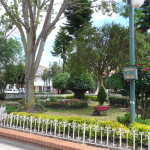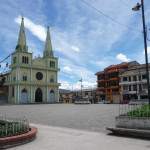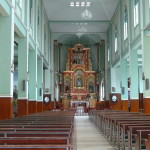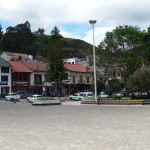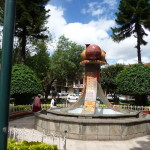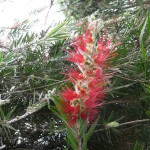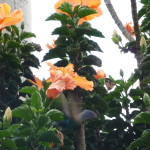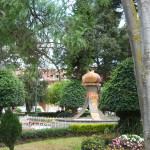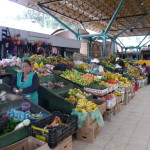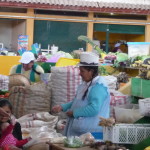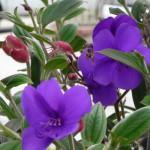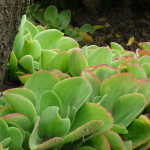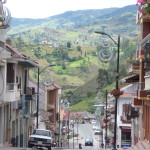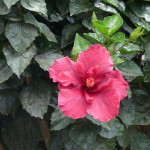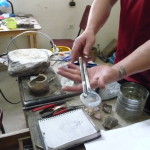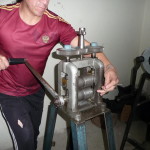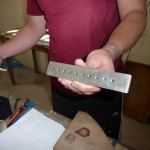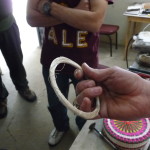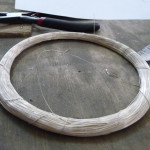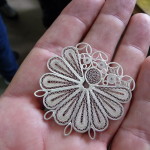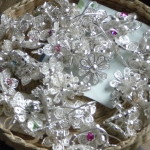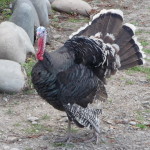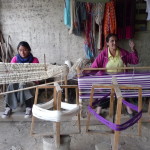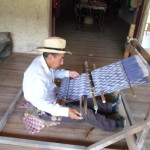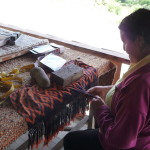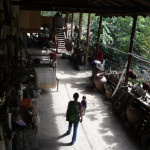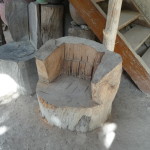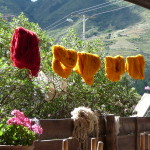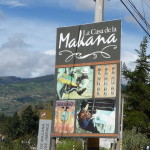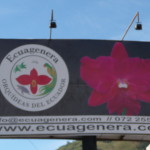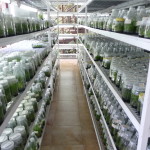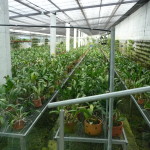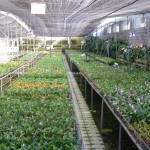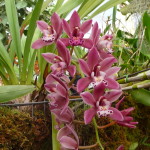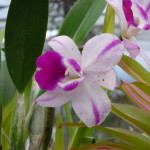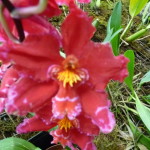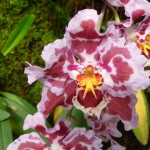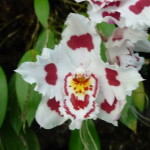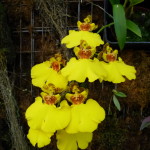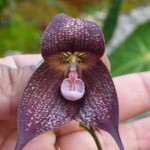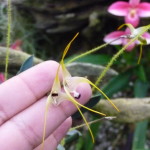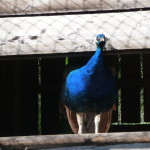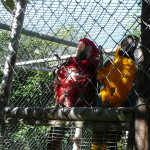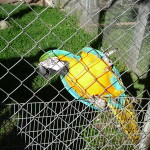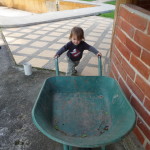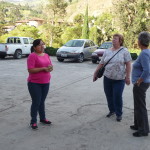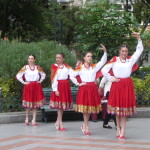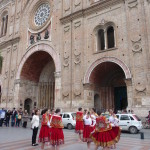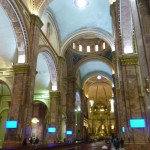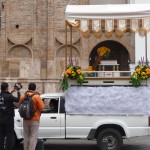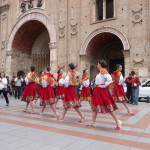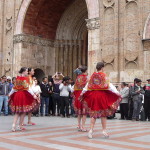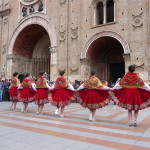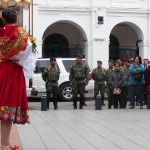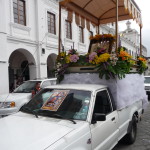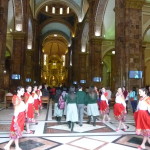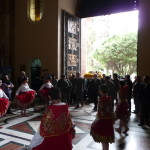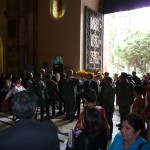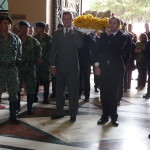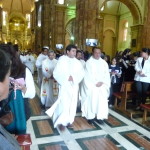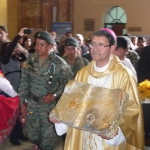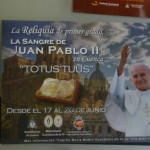Early on Saturday, June 13, 2015, I said goodbye to my hostal and hopped aboard a taxi that would take me to the “Terminal Terrestre” (Ground Terminal) – a huge, brand new bus terminal in the city of Guayaquil, Ecuador.
Literally twenty minutes after arriving at the bus terminal, I was boarding a direct bus that would take me into the Ecuadorian Andes mountains to a town called Cuenca.
This beautiful city is home to around 400,000 residents, and sits at an altitude between 7,710 – 8,370 feet (2,350 – 2,550 meters) above sea level. The climate here seems to be very similar to that of Cusco. It can be cold when the sun is hiding — and delightfully warm when the sun is brilliantly shining. My experience with this magical place is that it is very clean and has very peaceful energy. There are thousands of expats that call this place their home.
This post contains 262 photos telling the story of my week (so far) here in the mountains of Ecuador.
As usual, the photos in this post are thumbnail images. Please click on any photo to enlarge it. The thumbnails leave much to be desired as far as colors and resolution – plus the thumbnails clip all of the edges. I use thumbnails for the post itself, because it gives people an opportunity to get a summary glimpse without downloading huge amounts of data for the high-res photos.
CLICK ON ANY PHOTO TO ENLARGE TO HIGH RESOLUTION
Me, on my bus, as we begin to leave Guayaquil in the dust.
Crossing the bridge on one of the huge rivers that flows through the Guayaquil area (a sea-level town near the southwest coast of Ecuador).
The first part of our journey is flat, through gorgeous greenery … and soon we climb and climb and climb up the steep slopes of the Andes.
After a couple of hours we are way up in the gorgeous mountains.
More mountain scenery.
I am surprised as we cross a mountain pass, and then continue through an area with lots of lakes.
I later learn that this is part of Cajas National Park, and that the pass we crossed over was at 13,671 feet above sea level (4,167 meters) (according to Wikipedia). It was a very rainy day in the mountains.
Another mountain view with a few lakes in the background. I found it difficult to snap photos through the bus window – lots of raindrops on the glass.
A few hours later, I managed to find a few tourist maps of Cuenca before I asked a taxi to drop me off at a hostal that I had seen mentioned in my Lonely Planet tour book. Soon, I was checked into a really nice room – thinking I would just be here for a few days as I quickly explore the surrounding areas. Here I am now, a week later, still in that same hostal room, typing away on my computer.
City Tour
After getting settled in my sleeping quarters, I set out to explore (and to find an ATM). Soon, I hopped aboard a double-decker city tour bus.
The view from my seat as we wait to begin. The whole tour cost only $8.00.
Driving around the main plaza: Parque Calderon
The front of the “New Cathedral” here on the plaza. It is gorgeous inside. This is where I later had the experience with the dancers and the mass.
A gorgeous building on another corner of the plaza.
Just below my hostal, crossing into the new part of town, we come to a river area. From what I see, the entire river corridor is beautiful, green, and filled with grass and trees … a delightful place to hang out if I were so inclined.
Buildings and balconies … driving down one of the streets.
Driving beside one of the four rivers that call this city home. Every river I see is beautiful, surrounded by green.
Looking up at some expensive homes above the river. We are quite close to my hostal, which is up there somewhere behind those homes, and a few blocks to my right.
A view from a mountain near Cuenca, looking down over a major part of the city.
From the same view area, looking down at closer areas, and toward the left (West).
We are on the southern edge of Cuenca, and now I turn to look more toward the East.
Zooming in on the historic center of Cuenca. Just above left center you can see the three white domes of the New Cathedral … adjacent to the Parque Calderon.
Continuing our tour, passing beside more green areas that follow a river.
A beautiful building on one corner.
As we approach Parque Calderon at the end of our tour, we pass this flower market, just a half block from the plaza.
And this is a photo of a photo. At the start of our tour, the tour company took photos of all of us. At the end of the tour, they gave us a copy as part of the cost of our adventure. This is the photo they gave me. I took my own photo, because it is hard for me to carry extra things with me.
After the bus tour, I set off in search of an open travel agency. It seems that everything closes up here on Saturday afternoon – and even more so on Sundays. I finally found an agency just a half block from my hostal. I was happy to learn that I could go on a tour the very next morning – visiting the main natural attraction in the area.
Cajas National Park
At around 8:00 a.m. on Sunday morning, I stepped out of my hostal, standing on the street, hoping that some form of transportation would not forget to pick me up. Soon, a man in a small red car stopped to ask if I was waiting for a tour to Cajas. When I told him yes, he instructed me to get in. I questioned the safety at first, because the man had not even told me he was looking for “Brenda”. But my heart was at peace, saying go for it … so I trusted.
Five minutes later we picked up one more passenger. The other three who were scheduled to go with us had canceled. It was a very delightful and personalized tour …. and best of all, the sky was clear and we could see the distant mountains. It was going to be perfect weather.
Me, standing on the street, waiting to be picked up. I am very glad that the tour agency loaned me these rubber boots to wear. I needed them later on.
I took a photo of the front of my hostal while I waited … it is Hogar Cuencano. My room is on the second floor, looking out into an inner courtyard.
The empty street by my hostal, looking toward the travel agency on the next corner (right).
Finally, I am in the personal car of our tour guide (Wilson) … and we are driving back up the canyon, going back up the same road that I came down, just the day before.
After a while we turn off at this sign, which advertises the entrance to Llaviuca – a beautiful lake at the lower edges of Cajas National Park. Wilson tells us that we are going to walk around the lake while looking for birds and wildlife.
Crossing over one of the rivers that passes through this valley.
Climbing a little as we go through this gorgeous valley.
More of the scenery as we continue toward the lake.
The road was very bumpy – paved with large cobblestone rocks.
I could not resist taking a photo of these two children playing alongside the road.
Soon, we reach the entrance gate. Admission is free, but they do control the number of people allowed to enter each day. For instance, only 114 people are allowed to walk around the lake on any given day.
A map of Cajas National Park. If you look at the white area, that is the park. We are on the right side, right where that little brown protrusion ends coming in from the right. This is the lower end of the park. Eventually, we will cross through the upper part of the map.
The sign as we enter the parking lot for the lake area. The sign reads “National Park of Cajas, Recreation Zone of Llaviucu, 28,544 Hectors (70,533 acres), 3160 Meters (10,367 feet).
Below that, the white words read, “Area of importance for the conservation of birds”
Our massive tour bus.
Another map of the National Park of Cajas. I love such maps because they really help me to orient myself to the surrounding areas.
Scenery as we begin our walk.
Soon,, the lake comes into view. We will walk around it in a clockwise direction.
Wilson (our tour guide) is extremely knowledgeable about the plants and birds … and a very fun people person. He constantly stops to teach/show us things.
Down at the level of the lake with a gorgeous photo op.
Looking into the water from a small dock. Those plants below the shimmering surface act like the lungs of the lake, replenishing the oxygen.
Red Dartura flowers. Wilson spent considerable time telling us about the intoxicating nature of these medicine flowers … and how they are quite dangerous when used improperly. I really enjoy learning more about these flowers. Some shamans in the Amazon jungle mix a little of this into their Ayahuasca brew – and it can have beautiful or disastrous results.
I include a lot of wildlife and plant photos in this series. I was enthralled by the beauty and wanted to capture it all.
A beautiful little river that feeds the lake.
Looking upstream toward the source of this river. Later we will be up at the lakes that feed this small river. I think this one is the “Matadero River” … but am not fully sure.
Another Datura flower (I had never seen red ones before. I have often seen white and orange ones in my travels).
The back side of my tour-mate as we continue hiking on this small trail. Her name is Laia (Pronounded LIE-uh) … and I had a lot of fun talking to her.
looking back from whence we came.
Wilson gives us first glances of the “Quinoa” tree – it has reddish-brown paper-like bark. I have seen these trees (or ones similar) in different parts of the world. I love their bark.
A piece of the paper-like bark in my hand.
We are now on the other side looking back. There is another small dock on the near shore.
Standing on that dock, looking down into the water at more of those oxygen producing plants. The water is very clear here.
Me, on the dock …
… and another. It was chili here. I wore three layers and carried a coat in my backpack. It was not quite warm enough to remove my sweatshirt.
But I did suddenly realize that I was getting warm and at least unzipped it. Underneath is a long sleeved shirt that I bought in Iquitos (to use for mosquito protection while in the jungle).
… beautiful scenery.
I love the clouds behind the mountain.
Lots of moss in these trees. The climate seems to change, even at different parts of this lake.
This is actually a very tiny orchid (the tiny flower above the large leaf).
And another native orchid.
I got hooked on nature photos today.
… and another.
I love these “Brumela” plants. At least I think that is what Wilson calls them – part of the Pineapple family … they are growing all over these trees.
Zooming in a little.
There are so many unique species around this lake – plants that a different than any I have ever seen. (Maybe I am just looking more closely.)
A bird, just right of center, perched on that flowering tree.
Another bird on top of this colorful stump.
Laia, stopping to pose.
A constantly shifting climate, depending on what part of the lake we are at. This side is steep, along the mountain, and covered with thick canopy.
Wilson tells us that we might see some of the Tucan birds that live here … we walk very slowly as he occasionally makes a bird call … but we never see any of them.
I still fondly remember seeing my first Tucans in Tikal, in Guatemala.
Another vantage point.
Looking for those Tucan birds.
Finally, crossing the river on our way back to the other side of the lake.
Looking downstream.
Again … the climate shifts.
Walking on boards through a muddy area.
Some moss-covered branches along the path.
I LOVE this tree trunk.
More unique flowers on this tree.
As I check the time, I giggle and decide to take a photo of my disintegrating watch. If you look closely, you can see that the second hand is loose and clogging up the works between the hour and minute hands.
If you look again, you can see that the buckle on my wrist strap is missing. I had to get creative and tie the two ends together with a stiff bobby pin. I then clipped the watch to the strap of my little purse.
I finally buy a new one to replace it a few days after this. I always use a cheap watch in my travels. I don’t want to look rich to would-be robbers.
A map showing the lake (left center) with the little red road that leads horizontally back to the main highway (top center to right center).
We are back on the road again, driving higher toward the upper part of Cajas National Park.
So many gorgeous scenes up here.
Wow, I just noticed that the mountain in the center looks like a face staring to the left (click to enlarge).
These mountains are approaching 15,000 feet … higher than anything in Utah or Colorado.
Our guide tells us that this is a sacred mountain, where the ancients used to climb to celebrate the Moon Gods.
We are now passing through the higher areas of Cajas … still climbing.
Soon, we stop at Tres Cruces (Three Crosses) – the mountain pass that I noticed the day before on my journey from Guayaquil.
The altitude here is 4,166 meters (13,668 feet) … note, this is one meter shorter than the altitude listed by Wikipedia … hmmm :)
The altitude part of the sign … I love to pay attention to such details.
Another sign here on top of Tres Cruces.
And I see a map that shows Cajas as being between Guayaquil and Cuenca.
A little lookout tower above. If you look directly below it, among the rocks, you can see three crosses … Wilson tells us that this is to honor the people that died in the harsh conditions as they traveled over this pass from Guayaquil to Cuenca (centuries ago).
A different vantage point in which the crosses are easier to see.
Looking from that platform down the valley. Our next destination is one of those lakes down there.
Me, standing in the same place, with Wilson using my camera.
… and a slightly different view.
This is a fascinating growth of plants that Wilson tells us is called “Cushion”. It really does feel like a cushion when you walk across these.
Without a zoom, a beautiful “cushion” plant / cluster.
This area is filled with beautiful and unique flowers and plants.
Soon, we get back in the car and drive back down the highway, just a short distance, headed toward Cuenca.
We stop here. The sign that shows where we are. We are at “Toreadora” … which is the little black dot just left of the right-center edge of the thumbnail image. The altitude here is 3,979 meters (13,054 feet) above sea level.
Zooming in on the previous map – a clearer image of where we are.
… and the altitude (zoomed in)
In this map, I am at the larger blue lake right in the exact center.
A view of the lake as seen from the parking lot. Wilson tells us that we will walk around it in a counterclockwise direction.
Looking off the the right.
Looking down at the middle of the beautiful lake.
Preparing to walk down the trail to the right (doesn’t show in the thumbnail image).
Another plant like the “cushion” we saw above … only Wilson tells us this one is different. It has bigger leaves, and is more spread out.
This entire area overflows with magical plants.
… and flowers.
These make me vibrate inside…
Another view of the same type of plant. They fascinate me.
Continuing on as we approach lake level.
A beautiful plant with magical colors and patterns. Wilson tells us that it grows a tall trunk in the middle before it creates seeds and then dies. It only lives once.
Zooming in on the same plant.
And these flowers are almost like some I used to love back home … but quite different.
Zooming in on another slight variation.
Random scenery at this part of the lake.
I love the green in these leaves.
Me, at the far end of the lake. I am not sure why my hair looks as if it is in two pony tails … because it isn’t. (Giggles)
I love this photo.
Here is where my boots come in very handy.
We leave the lake for a while and head up to (and past) that little hill on the left.
I am not sure how to interpret this sign. Our entire hike took us about two hours and fifteen minutes, including the little detour to the right … but I am not sure if we visited a “refugio” (refuge) in that direction.
We are now standing on top of the hill I pointed out two photos ago. This is the view looking up toward the mountain pass (Tres Cruces).
Wilson and Laia. I’m not sure why he was giving me a thumbs up. I think I just finished a difficult climb.
Walking across some of those “cushion” plants. The ground here is very moist.
From the top of the same small hill, looking down the valley in the direction of Cuenca.
Slightly different angle.
Wilson took this photo for me. My hair still looks funny LOL
I completely misunderstood Wilson when he told us that we were going to walk over there to that forest. I thought he meant the one on the far side of the valley (back right center). As it turns out, it was the near one, in the bottom left corner of the photo.
Another view looking down the valley. This is taken from just above that near forest mentioned in the previous photo.
Soon, we approach that forest … seeing a sign that reads Bosque Quinoa (Quinoa Forest).
The photos just do not capture the real beauty of these places. This forest was incredible to see in person.
It is a maze of those same reddish-brown paper-like bark trees.
We follow the trail down a few hundred feet into the middle of this large area. I love it here.
Laia …
And now, ME … in the same general spot.
… and another of me.
… loving it in here.
The camera is level. We are just on the side of a hill.
It was awkward to move around in here … hillside … mud … lots of intertwined trees.
After a while we leave the forest and resume our hike … first heading back to the lake.
I loved this little tree. It reminds me of banzai trees.
And wow … the greens on this moss practically jumped out to hug and kiss me … they are so gorgeous.
A little stream coming down over the trail … creating a lot of the mud on this far side of the lake.
A view along the far side.
Just cannot get enough of this.
It was quite muddy on this side, and in places they gave us boards to walk on.
Looking down at the lake from above the north side (the parking area is on the west).
This is two of those plants that I talked about at the beginning — the almost cactus-like ones with the purple leaves that only have one life. When they grow these little trunks, they die and dry out as these are doing.
Looking up toward the road and visitor center (upper right).
… just a nice view.
Racing through the grass to catch up with Wilson and Laia.
So so many beautiful views here.
A fascinating clump of mossy stuff.
And beautiful flowers.
Me and Laia … with the lake in the background. We are almost back to the car.
Soon, we are back in the car, zooming toward Cuenca. While still near the National Park we stop for a late lunch (included in the tour). I had the Garlic Trout … I liked it but had to dig through lots of bones, being extremely careful not to swallow them.
Museum And Pumapungo
After returning to Cuenca, I asked Wilson to drop me off at this museum. It was already about 4:00 p.m., and the museum closed at 5:00 p.m., so I zoomed through, just to get the flavor of the place, taking a few token photos. At 5:00 p.m. I went outside and in back, where some old ruins are located. They are not much, but I enjoyed walking through them.
The front of the museum.
There are several exhibits here. I focused most of my short time on the one upstairs. It covers all of the indigenous cultures from all over Ecuador.
This is just one random display.
This and the following few photos are not necessarily something that I wanted to capture … just a variety of things to remind me what this museum was like.
When the guard told me they were closing in ten minutes, I went outside to the Pumapungo area.
This sign explains that Pumapungo was the administrative and religious quarter of the Kañari and Inca city of Tomebamba. The Kañari’s were a pre-inca civilization which some people told me was at least 2000 years older than the Incas … I have not done any research on them.
Part of the ruins … looks very restored.
… another piece close by … just lots of very low walls with no real information about the place.
… and another section.
A circular wall … (very little info about it, and no tour guides around).
More of the same.
Looking back over a larger area of these walls.
Looking more to the left from the same place.
Down below the ruins were some terraces. I can only guess that these were not built by the Incas (because of the loose fitting rocks) … they must predate the Incas … having been built during the Kañari times.
From the gardens further below, looking back at the terraces.
Another view with more zoom.
Half way up the terraces, I saw this gated cave.
The sign says it is a ‘possible’ dwelling place for mummies …
Looking through the bars down toward the inside. I used a flash, but according to the sign above, it looks as if the cave is quite deep.
From the cave, looking down at the beautiful park area below. I did not go down there to explore because I was tired and it was late.
With full zoom, looking toward what I believe to be the view area from where I took photos just two days ago.
Three City Tour
As I later returned my boots to the tour agency (they weren’t supposed to be open after my Cajas tour, but I saw the owner on the street in front of open doors) … I talked to the agent and felt good about signing up for an early morning tour … the very next day.
At around 9:00 a.m., we met up at the agency. We were five adults and one child. Three of the adults were expats living in Cuenca … and one was the daughter of one of the expats (visiting).
I had fun visiting with all of them, picking their brains for information on living here … hmmmm … you never know.
We drove for nearly an hour, climbing higher and higher into the surrounding mountains (I think we were generally heading west).
More of the scenery.
I knew almost nothing about this tour when we started … I just felt a nudge to join it … and I loved the company and many of the places we went.
Our first stop was the village of “San Bartolome”, where we drove down a street famous for being a place for guitar makers. This is where we stopped – at a place called Uyaguari Guitars.
The family here is famous for their handmade guitars …
It is a very modest and humble adobe house, with a small workshop and large display area of guitars for sale. The only thing they showed us is how they do the pattern inlays on the face of the guitar.
They cut very small strips of wood … then dye them in various colors. Then they glue the colored strips together in various patterns. Finally, they cut up the glued wood and piece it meticulously together to form the patterns in the inlays.
The inlays I am talking about are the beautiful patterns that surround the hole to the acoustic chamber beneath the strings. That is not just a painted pattern. It is a fancy mosaic of colored wood chips.
The young man who gave us the demonstration of the inlays.
Part of an inlay being placed into this strip of wood … I believe this is just for showing an example.
They dig a groove in the wood and then fill it with the colored chips.
Kay and Joan, looking at things to buy. I just stood around at this point. I never buy anything (well almost never). I simply cannot carry stuff when traveling for so long, and would not know what to do with it if I did buy something.
A view from the guitar makers house. Our next stop is the town on the far side of the valley, up on that hill.
Another view of the area.
Some of the colored wood strips that they use to make the inlays. That is my hand touching them. They are thin wood, about 1/16 of an inch thick. Each dyed and ready to glue into a bigger pattern.
the young man doing our demonstration – and selling to my friends.
Joan, her daughter Judy, and grandson Garret, out enjoying the view while we wait.
As we passed this woman, our guide had the driver stop so he could talk to her. She is holding strands of some type of plant. These strands are hand woven into Panama Hats. Our tour does not show us this, but our guide wanted to make contacts for possible future tours.
Approaching our next town – a place renowned for its silver jewelry – all handmade (at least most of it).
Passing some of the plants (used for Panama Hats) that are drying by the side of the road.
… and more of the same plants.
One of the streets of this town.
I thought that Chaurinzhin was the name of the town, but that is the name of the area. The town had a different name.
I was surprised when there was no official tour in this town. We were just brought here to enjoy free exploring time … and to peruse the silver jewelry shops. I spent some time with my tour-mates in a shop … even considered buying some earrings … but didn’t find anything that appealed to me (and I was very limited on cash).
So I began to explore. The previous photo was the town square. This is a church in front of a cobblestone plaza next door.
Inside the church.
Looking back from the church.
I thought this little fountain (in the center of the park area) was cute.
And there were some very pretty plants growing in the park area.
More beautiful and unique flowers.
A different view of the park.
Soon, I briefly walked to the town market – a market I had seen from the van as we drove through town.
It was fun, but there was not much to see.
So very soon, I found myself back in the park, looking for more photo opportunities.
Such a fun variety of plants.
This street has giant silver earrings hanging from the light poles.
More flowers.
Finally, we loaded back up in the car and began to drive away. As we passed one house, the guide told us that he knew a family here that made the jewelry, and he asked if we would like to deviate from the tour to see if they would let us come inside.
Soon, we were inside watching how the pure silver is first put into bars, and then gradually formed into very thin silver wire.
In this photo, the man is holding two silver bars in his left hand. It starts out as tiny chunks and he melts them and puts them into a mold to form these bars.
Then the bars are repeatedly run through this hand operated press (with lots of groves in it) … gradually squishing the bars, making them longer, turning them into thinner rods.
Then the thinner rods are successively pulled through these various size holes, repeatedly until they get thinner and thinner.
This is the result of pulling the bars into wire. This is not a solid bar … it is tiny silver wire simply coiled up for easy handling.
Zooming in a bit to see that it is a coil of wire.
It takes hours and hours to make the wire. Then they take two strands of wire and wind them tightly together before flattening them again in the press. That final flattened wire has texture because of the two wires flattened together. That textured, flattened wire is then used to fill the patterns on the jewelry – jewelry like this one. Each area of this pendant is filled with tiny strands of that silver wire.
Someone noticed this little basket of silver earrings and asked if they could buy some. The tour soon turned into shopping. I actually bought one pair of these, and another pair with little red ruby-like stones in them – both pairs intricately made with this flattened silver wire.
I needed earrings and he sold us these solely by weight – the cost of the silver itself. I paid $25.00 for my two pair (total).
Our next stop was at a textile weaving factory – a family operated business. I have seen so many of these in my travels – all so similar – that I was not all that interested.
But I loved this turkey outside :).
Some of the demonstration, working with laying out the threads prior to weaving.
Apparently, in this part of the world, the women do the prep work and the men do the actual weaving. Don’t ask me why … that is just what they told us.
This woman is doing the finish fringe work on this shawl.
From upstairs, looking at the work area below.
A bench made from an old tree stump (or fat log).
Some of the hand-dyed yarn, made with natural colors.
The name of this place was “The house of Makana”.
After stopping at a yummy lunch place ($3.00 each, included in the tour), we began to return to Cuenca.
Aren’t we going to the Orchid Farm? I asked several of my friends on the tour. Every one of us was under the impression that we were – and that we would have to pay our own admission because it is not normally part of the tour. The travel agent told us all to bring extra money for that part because Judy had specifically asked if we could stop there.
Finally, we asked the tour guide when we were going to see the Orchids. He grumbled at us and told us that the Orchids are not part of the tour. I insisted that he call the travel agency to verify what we were telling him. Finally, after a grouchy phone call, he agreed to take us there. We had to backtrack almost 30 minutes … but it was well worth it. It was one of the main things that interested me in the first place.
This is the sign in front of this very large family-run, very professional Orchid farm. In this place they have something like 47 greenhouses, and grow 3500 different species of orchids that are native to Ecuador … plus another 3500 hybrid species that they are playing with.
The orchids start off as small numbers of seeds, planted into a fertile gelatin mix and sealed in bottles – then stored and monitored on shelves like these.
When the seeds grow and sprout to be large enough, they tediously remove them using tweezers, one by one, planting them in separate cups.
Part of a greenhouse growing the orchids.
Another huge area of a different greenhouse.
Our guide (from the family business – not our agency guide) took us into a room filled with hundreds of beautiful orchids … and there was so much variety it was mind boggling.
The next collection of photos is just a sampling of what was growing in that room. I selected some of my favorites.
If you use your imagination, you can easily see why these orchids are called “dancers”.
And this one is called the monkey face orchid. (Our guide had to pull back the top petal to reveal the face.
Some are extremely tiny.
We spent a long time enjoying that magical orchid room. Then we went outside for a short stroll. This beautiful peacock was in a large cage on the property.
… and next door were some beautiful birds … I think these are McCaws … but I am not an expert (nor do I know how to spell the name).
… another beautiful bird in the same cage.
Garret playing with a wheelbarrow. He was such a fun addition on the tour. We had a lot of fun turning our heads to make eye contact, grinning or giggling, and then turning around … repeating said action over and over.
The woman in pink is our tour guide. Her family has established and run the farm for a very long time. She spoke excellent English. That is Kay and Joan on the right. They both live here in Cuenca.
Following Intuitive Guidance
I wrote about this in a recent written blog entitled “Forget Everything You Know”, published on June 17, 2015.
Because I have already shared the story at the end of that blog, I will not go into much detail here. I simply want to share the beautiful photos that go along with the story.
Just to fill in a few details for background, It was just around 10:45 a.m. on June 17, 2015. I was struggling with a little writer’s block as I tried to write for my “friend project”. Rather than sit and stare, I followed guidance to get out of my room and to explore.
I found these beautiful dancers in the main Parque Calderon … waiting to begin some type of performance.
At this point, they were just rehearsing a little, going over their positions on the ground, and doing a lot of standing around and waiting. I did the same.
Still rehearsing.
I even followed them inside the cathedral, wondering why they would go inside there. For a few minutes, they were also rehearsing their positions for something inside.
Returning back outside, the street was closed, this pickup truck / float pulled up, with a large canopy on top, and some type of golden bible-like book on a pedestal.
Soon, the girls began their official performance.
Their dancing was very emotional and touching to me …
I was mesmerized by their energy and their costumes.
When the dance concluded, I noticed these military-like guards, guarding the truck.
A better view of the truck. As I took this photo, I noticed the poster talking about Pope John Paul II, taped inside the window.
I followed as a group of men removed the golden bible-like book from the truck and carried it on their shoulders, into the back of the cathedral. They stood there in the back for at least fifteen minutes. The dancers had gone inside to form a barrier, visually showing people the boundaries of where they should not pass.
The men just stood there, waiting for something, preparing to walk down the aisle.
Still there (with a little zoom).
… and a little more zoom. you can barely see the golden-colored bible-like book.
Finally, the Catholic priests came from the front of the cathedral to escort the precious item (I still did not know what it is).
Two of the nuns took the book off the tops of the shoulders of the men and handed it to the Priest, who carried it down the aisle.
By this time, the entire cathedral was nearly filled with reverent devotees.
As the procession neared the front of the cathedral, I began to leave …
Then I saw this poster by the front door. It explained everything. This “golden bible” somehow carried “The blood of Pope John Paul II” who died in 2005. It would be on display in Cuenca from June 17 to 20, 2015. Given that today was June 17, I realized that I was witnessing a room full of loving people who were welcoming the arrival of an emblem honoring a leader that they very much revered.
Following guidance, I returned inside to observe for a little longer. I started paying deep attention to what I was feeling. I was feeling an incredibly strong sensation of loving energy running through me – taking me almost to the point of tears. I realized that what I was feeling had nothing to do with the Catholics, or with any belief system in general — it was just pure simple divine love radiating from the people who were opening their hearts in the only way they knew how – in a genuine and pure way.
I wrote more details about how this affected me in the previously-referenced blog.
Summary
When I came to Cuenca, I really had no intention of staying for a week or more. I expected to spend a few days playing tourist and then move on.
But once I got here, and finished my fun tours, I felt deeply inspired to get caught up on my writing, and then on my photos – the whole idea brought me deep peace.
Now, as I enter my eighth night in this beautiful city, I am finally caught up with those tasks, and it feels great. I will likely stay here for maybe one more day, simply resting, enjoying the city, and maybe making a Skype call or two.
Perhaps I will move on this coming Monday … but you never know.
Copyright © 2015 by Brenda Larsen, All Rights Reserved
